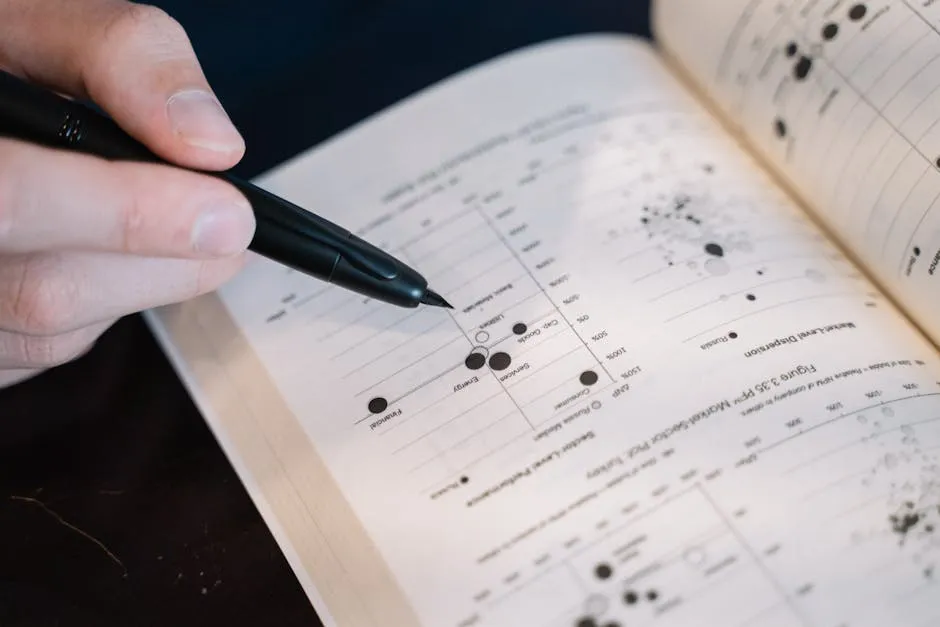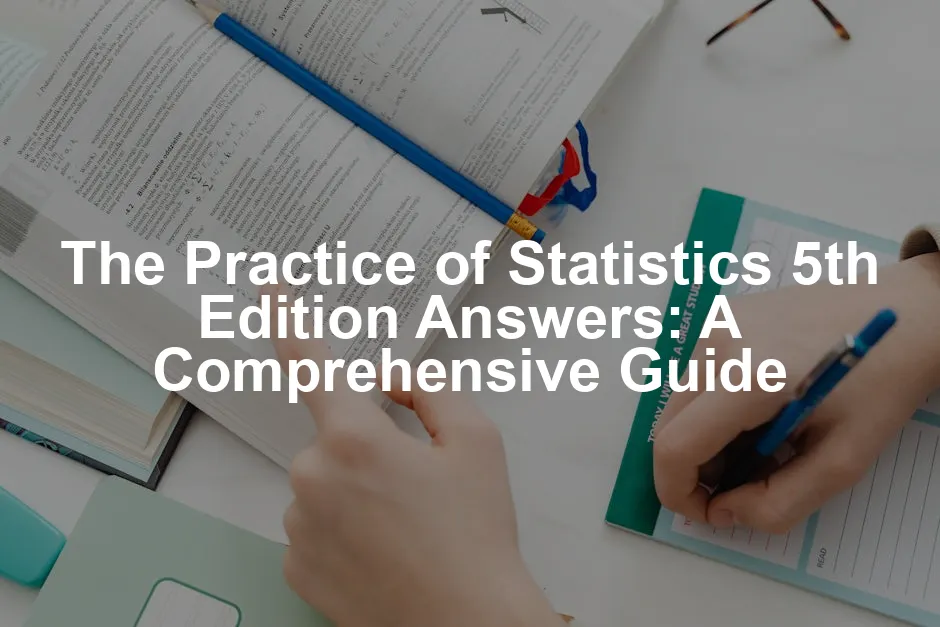Introduction
Statistics can feel like a daunting mountain to climb. But fear not, because “The Practice of Statistics” textbook is your trusty guide! Authored by the brilliant minds of Dan Yates, David S. Moore, and Josh Tabor, this book is a beacon for students navigating the intricate world of statistics. Whether you’re tackling hypothesis testing or exploring regression analysis, this book is crucial for anyone looking to excel in their statistics courses.
But why is having access to the answers for the 5th edition so important? For starters, it’s not just about finding the correct answers—oh no! It’s about comprehending the material. Students often struggle with complex concepts, and having the right answers at their fingertips can make a significant difference. This article will shed light on how to access these solutions and the various resources available to support your learning journey.
So, are you ready to take your statistics game to the next level? Let’s dive into the nitty-gritty of finding answers for the 5th edition of “The Practice of Statistics.” With the right tools and resources, you’ll not only improve your grades but also develop a genuine understanding of statistical concepts. Keep reading to discover how you can harness these resources to boost your studies and performance!

Understanding the 5th Edition Textbook
Overview of “The Practice of Statistics”
This textbook is more than just a collection of pages; it’s a well-structured learning experience! Written by the dynamic trio—Dan Yates, David S. Moore, and Josh Tabor—the 5th edition is packed with updated content, clear explanations, and practical examples. Each chapter is designed to build upon the last, ensuring you grasp the material cohesively.
The textbook covers a broad spectrum of topics in statistics. From descriptive statistics to inferential methods, every chapter is an opportunity to learn something new. Each section includes real-world applications that help students see the relevance of statistics in everyday life. Who knew numbers could be so exciting?
Understanding descriptive statistics is crucial for grasping more advanced statistical concepts. Learn more about descriptive statistics in manufacturing plants.
Importance of Answers and Solutions
Now, let’s talk about the elephant in the room: why do students need access to solutions? Imagine standing on the edge of a cliff, looking down at a sea of equations and graphs. It’s intimidating! Solutions serve as life rafts, guiding students through the stormy seas of statistical challenges.
However, it’s crucial to remember that simply having answers isn’t enough. Students should focus on understanding the ‘why’ behind the solutions. This deeper comprehension fosters critical thinking—an essential skill for tackling future statistical problems. It’s like learning to fish instead of just being handed a fish; you’ll be well-equipped for any statistical challenge that comes your way!
In summary, “The Practice of Statistics” 5th edition is not just a textbook; it’s a comprehensive resource that, when paired with the right solutions, can transform your understanding of statistics. With these answers, you can navigate the complexities of the subject and emerge as a confident statistician!

Available Resources for Answers
Step-by-Step Solutions
Introduction to Study Tools
When tackling the daunting world of statistics, having the right resources is crucial. Two popular platforms, StudySoup and Chegg, stand out when it comes to finding detailed solutions to textbook problems. These tools provide step-by-step answers that help students bridge the gap between confusion and clarity.
StudySoup offers a treasure trove of resources. Here, you’ll find not just answers, but also class notes and exam study guides. Think of it as your personal statistics tutor, available at any time! Chegg takes it a step further, providing comprehensive solutions specifically for “The Practice of Statistics” 5th edition. With both written and video formats available, these platforms cater to various learning styles, ensuring that no student is left behind.

To enhance your study environment, consider investing in a Desk Organizer. A clutter-free space can lead to a clutter-free mind! You’ll be surprised how much more focused you can be when your study area is tidy.
How to Use These Resources
To maximize your learning, start by searching for specific problems you’re struggling with in the textbook. When you find the answer, don’t just skim through it. Instead, take time to understand the reasoning behind each step.
Here’s a nifty tip: try to attempt the problem on your own first. Once you see how your attempt compares to the provided solution, you’ll gain insight into where you might have gone wrong. This approach not only reinforces your learning but builds confidence! Additionally, take advantage of the video explanations offered by these platforms. Watching someone else solve the problem can illuminate the process, making it easier to grasp complex concepts.

Video and Interactive Content
Visual Learning Resources
Let’s face it—sometimes, reading a textbook just doesn’t cut it. Thankfully, there’s a wealth of video content available to help make those tricky statistics concepts stick! Platforms like StudySoup and Chegg not only provide written answers but also interactive video explanations that enhance understanding. These visuals can simplify complex ideas, transforming abstract concepts into concrete knowledge.
For visual learners, these resources are pure gold! You can find videos that break down each chapter, illustrating key concepts in a digestible format. This multimedia approach promotes better retention, making it easier to recall information during exams.

Benefits of Multimedia Learning
Incorporating video content into your study routine can be a game changer. Studies show that learners who engage with multimedia materials often perform better than those who rely solely on traditional text. Why? Because different formats cater to various learning preferences. You might find that seeing a concept visually presented resonates more than reading about it.
Moreover, interactive guides allow you to pause, rewind, and review difficult sections as many times as needed. This flexibility empowers you to learn at your own pace, making statistics feel less overwhelming and more manageable.

Community and Peer Support
Joining Study Groups
Learning doesn’t have to be a lonely endeavor! Joining study groups is an excellent way to enhance your understanding of statistics. Platforms like Discord host vibrant communities where you can connect with fellow students. Collaboration fosters a sense of camaraderie that can make studying more enjoyable. Plus, discussing problems with peers often leads to new insights and perspectives.
Study groups also provide accountability. When others are counting on you to contribute, you’re more likely to stay on top of your studies. So, gather your classmates and form a study group! You’ll be surprised at how much more enjoyable (and effective) studying can be when you’re not going it alone.

Utilizing Classmates’ Notes
Another excellent strategy is to share notes and study materials with your classmates. If someone in your circle takes better notes or has a different approach to a problem, it can be incredibly beneficial. By pooling your resources, everyone can fill in their knowledge gaps, ensuring a more comprehensive understanding of the material.
Don’t hesitate to ask for help when you’re stuck, either! Your classmates might have already tackled the very problem that’s giving you a headache. Remember, teamwork makes the dream work, especially in the challenging landscape of statistics!
With the right resources and support, mastering “The Practice of Statistics” 5th edition becomes a much more achievable goal. Embrace these tools, and you’ll find that statistics transforms from a source of stress to a subject of fascination!

Breakdown of Solutions by Chapter
Chapter-by-Chapter Overview
In this section, we’ll break down the key concepts, common problems, and examples of solutions for each chapter in “The Practice of Statistics” 5th edition. This will provide a structured way to understand the material and help you tackle the exercises with confidence.
Chapter 1: Introduction to Statistics
– Key Concepts Covered:
– Definitions of variables
– Types of variables: categorical vs. quantitative
– Common Problems:
– Identifying types of variables in given scenarios.
– Classifying data from various studies.
– Example Problem:
Suppose a researcher studies the effect of different fertilizers on plant growth. Identify the types of variables involved.
– Solution:
– Categorical Variables: Type of fertilizer (e.g., organic, synthetic).
– Quantitative Variables: Growth height of plants measured in centimeters.

Chapter 2: Data Collection Methods
– Key Concepts Covered:
– Sampling methods: random, stratified, cluster sampling.
– Importance of representative samples.
– Common Problems:
– Determining the appropriate sampling method for a study.
– Analyzing the potential bias in sampling.
– Example Problem:
A survey seeks to understand student opinions on campus food. Which sampling method would minimize bias?
– Solution:
– Stratified Sampling: Divide the student population by year (freshman, sophomore, etc.) and randomly select participants from each group.

Chapter 3: Descriptive Statistics
– Key Concepts Covered:
– Measures of central tendency (mean, median, mode).
– Measures of variability (range, variance, standard deviation).
– Common Problems:
– Calculating mean and median from a dataset.
– Interpreting standard deviation in context.
– Example Problem:
Given the test scores: 75, 88, 92, 85, and 78, find the mean and standard deviation.
– Solution:
– Mean: (75 + 88 + 92 + 85 + 78) / 5 = 83.6
– Standard Deviation: Calculate variance first, then take the square root for standard deviation.

Chapter 4: Probability
– Key Concepts Covered:
– Basic probability rules.
– Independent and dependent events.
– Common Problems:
– Calculating probabilities from given events.
– Using probability rules to solve problems.
– Example Problem:
If two dice are rolled, what is the probability of rolling a sum of 7?
– Solution:
– Possible combinations: (1,6), (2,5), (3,4), (4,3), (5,2), (6,1).
– Total combinations = 36.
– Probability = 6/36 = 1/6.

Chapter 5: Discrete Random Variables
– Key Concepts Covered:
– Definition of discrete random variables.
– Probability distributions and expected value.
– Common Problems:
– Finding the expected value of a random variable.
– Constructing probability distributions.
– Example Problem:
A game involves rolling a die and winning the number shown. What is the expected value?
– Solution:
– Expected value = (1/6)(1) + (1/6)(2) + (1/6)(3) + (1/6)(4) + (1/6)(5) + (1/6)(6) = 3.5.

Chapter 6: Continuous Random Variables
– Key Concepts Covered:
– Characteristics of continuous random variables.
– Normal distribution and its properties.
– Common Problems:
– Identifying normal distribution parameters.
– Calculating probabilities using Z-scores.
– Example Problem:
If a test scores are normally distributed with a mean of 75 and a standard deviation of 10, what is the probability of scoring above 85?
– Solution:
– Find Z = (85 – 75) / 10 = 1.
– Use Z-table to find the probability of Z > 1, which is approximately 0.1587.

Chapter 7: Sampling Distributions
– Key Concepts Covered:
– Understanding the central limit theorem.
– Sampling distribution of the sample mean.
– Common Problems:
– Finding the standard error of the mean.
– Applying the central limit theorem.
– Example Problem:
If the population mean is 50 and standard deviation is 5, what is the standard error for a sample size of 25?
– Solution:
– Standard Error = σ/√n = 5/√25 = 1.

Chapter 8: Estimation
– Key Concepts Covered:
– Point estimates vs. interval estimates.
– Confidence intervals for means and proportions.
– Common Problems:
– Calculating confidence intervals.
– Interpreting the margin of error.
– Example Problem:
For a sample mean of 100 with a standard deviation of 10 and a sample size of 30, calculate a 95% confidence interval.
– Solution:
– Margin of error = Z(α/2) * (σ/√n). Using Z = 1.96, CI = 100 ± 1.96(10/√30).
Chapter 9: Hypothesis Testing
– Key Concepts Covered:
– Null and alternative hypotheses.
– Type I and Type II errors.
– Common Problems:
– Performing hypothesis tests for means.
– Determining p-values.
– Example Problem:
A manufacturer claims their light bulbs last 1000 hours. Test this claim at α = 0.05 with a sample showing a mean of 950 hours.
– Solution:
– Set up H0: μ = 1000, H1: μ < 1000. Use a t-test and compare p-value to 0.05.
Chapter 10: Inference for Proportions
– Key Concepts Covered:
– Confidence intervals for proportions.
– Hypothesis testing for proportions.
– Common Problems:
– Calculating confidence intervals for population proportions.
– Testing hypotheses about proportions.
– Example Problem:
In a survey, 30 out of 100 respondents prefer chocolate. Calculate a 95% confidence interval for the proportion.
– Solution:
– CI = p̂ ± Z(α/2) * √(p̂(1-p̂)/n).
Chapter 11: Comparing Two Proportions
– Key Concepts Covered:
– Methods for comparing two population proportions.
– Using confidence intervals and hypothesis tests.
– Common Problems:
– Determining if proportions are significantly different.
– Calculating pooled proportions.
– Example Problem:
In two groups, the proportions of success are 0.6 and 0.4. Test if they are significantly different.
– Solution:
– Use a two-proportion z-test to compare.
Chapter 12: Comparing Two Means
– Key Concepts Covered:
– Independent and paired samples.
– t-tests for comparing means.
– Common Problems:
– Choosing between independent vs. paired t-tests.
– Calculating confidence intervals for the difference in means.
– Example Problem:
Compare test scores from two different teaching methods with means of 78 and 85.
– Solution:
– Conduct a two-sample t-test to determine if the difference is significant.
Chapter 13: Analysis of Variance (ANOVA)
– Key Concepts Covered:
– Understanding one-way ANOVA.
– F-tests and their applications.
– Common Problems:
– Performing ANOVA calculations.
– Interpreting ANOVA results.
– Example Problem:
Assess the means of three groups to see if they differ significantly.
– Solution:
– Use ANOVA table to find F-statistic and compare with critical value.
Chapter 14: Linear Regression
– Key Concepts Covered:
– Understanding the least squares method.
– Interpreting regression coefficients.
– Common Problems:
– Calculating regression equations.
– Analyzing residuals.
– Example Problem:
Predict Y based on X with a regression equation of Y = 2X + 3.
– Solution:
– For X = 5, Y = 2(5) + 3 = 13.
Chapter 15: Chi-Square Tests
– Key Concepts Covered:
– Chi-square tests for independence and goodness of fit.
– Interpreting chi-square values.
– Common Problems:
– Setting up contingency tables.
– Calculating chi-square statistics.
– Example Problem:
Analyze the relationship between gender and voting preference.
– Solution:
– Create a contingency table, calculate chi-square, and compare to critical value.
Tips for Effective Studying
Best Practices for Using Solutions
Studying statistics can be a rollercoaster ride. One moment you’re in the fast lane, and the next, you’re stuck in a loop. Fear not! The right study techniques can help you navigate this thrilling journey.
Active Learning Techniques
First up, embrace active learning. Before you peek at the answers, give the problems a shot on your own. This is like trying to assemble furniture without the instructions—frustrating, yet rewarding! Attempting problems first helps you grapple with the concepts. Once you consult the solutions, compare your approach with the provided answer. Did you get the same result? If so, high five! If not, try to identify where you went off track. Understanding the ‘why’ behind the solution is key.
Creating a Study Schedule
Next, let’s talk about organizing your study time. A well-structured study schedule is your best friend. Allocate specific time slots for tackling textbook problems and reviewing solutions. Think of it as a date with statistics—block off that time and stick to it! This routine helps reinforce your learning. Make sure to include breaks; your brain needs to recharge! You can even reward yourself after completing a study session. A snack, a short walk, or an episode of your favorite show can do wonders for motivation.

If you’re looking to keep your study area cozy and functional, a Ergonomic Desk Chair can make all the difference. Say goodbye to back pain and hello to productivity! Your back will thank you.
Staying Organized
Keep Notes and Summaries
Staying organized is crucial for effective studying. Keep notes and summaries for each chapter. This acts like a roadmap, guiding you through the material. Jot down key concepts, important formulas, and your thoughts on the problems. Create a separate section for challenging areas. This way, you can easily revisit topics that need more attention.
Consider using colorful sticky notes or digital tools to keep everything tidy. Visual aids can enhance your understanding. Plus, there’s something satisfying about crossing off completed topics! By tracking your progress, you’ll see how far you’ve come—and that’s a confidence boost!
In summary, effective studying involves active engagement with problems, a structured approach to scheduling, and organized note-taking. By implementing these strategies, you’ll transform statistics from a daunting subject into a conquerable challenge. Embrace the process, and watch your understanding soar!

Conclusion
To wrap things up, let’s revisit the key resources available for students seeking answers to “The Practice of Statistics” 5th edition. First on the list are platforms like StudySoup and Chegg. Both offer step-by-step solutions to textbook problems. These resources are not just about getting answers; they provide valuable insights into the thought processes behind the solutions.
StudySoup is a treasure trove of learning materials. You can access class notes, exam guides, and even video explanations that simplify complex concepts. Chegg, on the other hand, stands out with its comprehensive solution manuals that cover all chapters in detail. Students can find a wealth of resources here to help them master their coursework.
Let’s not overlook the importance of community support. Joining study groups, connecting with classmates, and utilizing online forums can enhance your understanding significantly. Collaborative learning can turn a daunting subject into a more manageable one, as you gain new perspectives and insights from your peers.
Now, a little motivation for you, dear student! Embrace these resources wisely. They are here to guide you through the labyrinth of statistical concepts. Use them not just to find answers but to deepen your understanding. Remember, the goal is not merely to complete your assignments but to develop critical thinking skills that will serve you well in your academic journey and beyond.
Finally, mastering statistics is crucial for academic success and opens doors to numerous career opportunities. Whether you’re aiming for a career in data analysis, research, or any field that relies on sound statistical knowledge, the skills you acquire now will be invaluable. So, roll up your sleeves, grab those resources, and embark on your quest to conquer statistics. You’ve got this!

FAQs
Common Questions About the 5th Edition Solutions
What resources are available for the Practice of Statistics 5th Edition?
Students can access a variety of resources for the 5th edition, including platforms like StudySoup and Chegg. These provide step-by-step solutions, video explanations, and community support to enhance your learning experience.
Are solutions available for all chapters?
Yes, solutions are available for all chapters in “The Practice of Statistics” 5th edition. Platforms like Chegg specifically list solutions for each chapter, ensuring comprehensive coverage of the material.
How can I find additional help outside of the textbook solutions?
In addition to textbook solutions, students can seek help through online forums, tutoring services, and by attending professor office hours. Engaging with classmates in study groups can also provide valuable insights and understanding.
What’s the best way to understand the solutions provided?
To truly grasp the solutions, attempt the problems on your own first. Once you have given it a shot, compare your method and results with the provided solutions. This approach not only reinforces learning but also helps you understand the concepts more clearly.
How to Get Help
Where to Look for Additional Resources
For further assistance, students can turn to online communities such as Discord groups dedicated to statistics, or utilize tutoring services that specialize in statistical education. Don’t forget to make the most of your professor’s office hours, where you can get personalized help. Engaging these resources ensures that you’re never alone in your academic journey!
Please let us know what you think about our content by leaving a comment down below!
Thank you for reading till here 🙂
All images from Pexels




